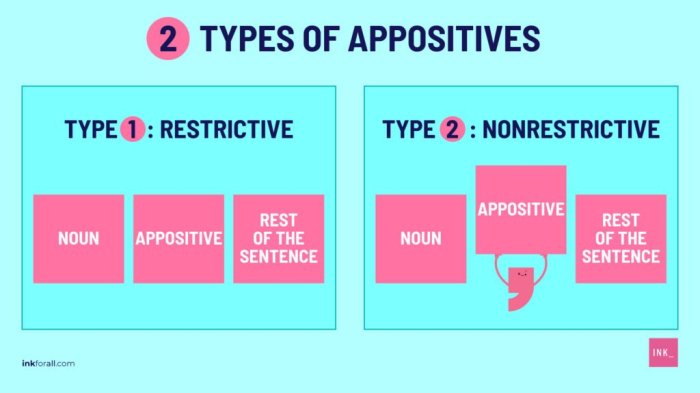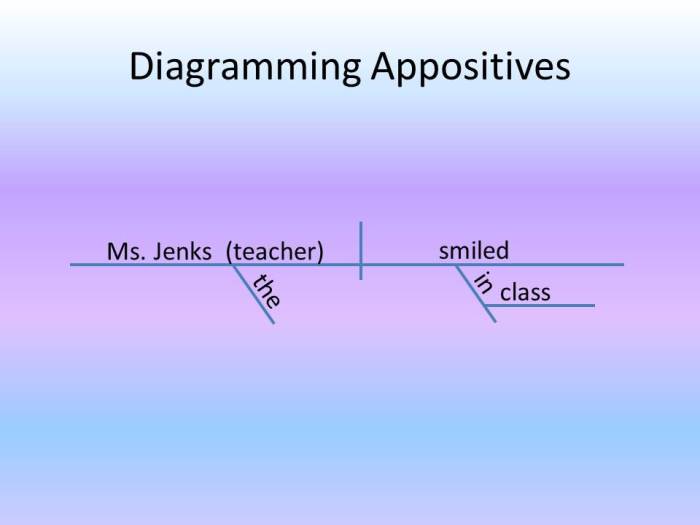How do you diagram an appositive – How to diagram an appositive is an intriguing topic that delves into the intricacies of English grammar, unveiling the art of diagramming sentences to elucidate their structure and relationships. This guide embarks on a journey to decipher the complexities of appositives, empowering readers with the knowledge to master this grammatical concept.
An appositive, a grammatical element that adds descriptive or identifying information to a noun or noun phrase, plays a pivotal role in sentence construction. Understanding how to diagram an appositive is essential for comprehending the nuances of sentence structure and effectively conveying meaning in written communication.
Defining an Appositive
An appositive is a noun or noun phrase that renames or identifies another noun or noun phrase that it immediately follows.
Appositives provide additional information about the noun they refer to and can be used to clarify, describe, or identify the noun.
Examples of Appositives
- My friend, John, is a doctor.
- The capital of France, Paris, is a beautiful city.
- The president of the company, Ms. Smith, gave a speech.
Diagraming an Appositive

Diagraming an Appositive
Diagraming an appositive involves several steps:
- Identify the appositive phrase within the sentence.
- Draw a slanted line above the appositive phrase.
- Connect the slanted line to the noun it is renaming.
- Label the appositive phrase as “AP.”
Example Sentence Diagram
Sentence: The president, Joe Biden, addressed the nation.Diagram:“` | AP |
—–
The president, Joe Biden, addressed the nation.“`
Symbols and Conventions
*
-*Slanted line
Indicates the appositive phrase.
-
-*AP
Label for the appositive phrase.
-*Connection to noun
The slanted line connects the appositive phrase to the noun it is renaming.
Types of Appositives: How Do You Diagram An Appositive
Appositives can be classified into three main types based on their function and relationship to the noun they modify:
Restrictive Appositives
Restrictive appositives provide essential information that identifies or defines the noun they modify. They are not set off by commas and are considered part of the noun phrase.
Example:
The capital of France, Paris, is a beautiful city.
Nonrestrictive Appositives
Nonrestrictive appositives provide additional information about the noun they modify but are not essential for its identification. They are set off by commas and are not considered part of the noun phrase.
Example:
My friend, Sarah, is a talented artist.
Appositives
appositives provide a synonym or definition for the noun they modify. They are typically enclosed in parentheses or dashes.
Example:
The boy
- a mischievous imp
- ran through the playground.
Punctuation of Appositives

Appositives are punctuated differently depending on their relationship to the noun they modify. Commas, dashes, and parentheses are the three main punctuation marks used with appositives.
Commas, How do you diagram an appositive
Commas are used to separate an appositive from the noun it modifies when the appositive is not essential to the meaning of the sentence. An essential appositive is one that provides information that is necessary to identify the noun it modifies.
For example, in the sentence “My friend, John, is a doctor,” the appositive “John” is essential because it identifies which friend is being referred to. Therefore, no commas are used.
However, in the sentence “My friend John is a doctor,” the appositive “John” is not essential because the noun “friend” is already specific enough. Therefore, a comma is used to separate the appositive from the noun.
Dashes
Dashes are used to set off an appositive that is more emphatic or important than the noun it modifies. For example, in the sentence “My friend—the one who saved my life—is a doctor,” the appositive “the one who saved my life” is set off with dashes because it is more important than the noun “friend.”
Dashes can also be used to set off a series of appositives, as in the sentence “My friend—a doctor, a lawyer, and a teacher—is a very talented person.”
Parentheses
Parentheses are used to set off an appositive that is or parenthetical. For example, in the sentence “My friend (the one who saved my life) is a doctor,” the appositive “the one who saved my life” is set off with parentheses because it is .
Parentheses can also be used to set off a series of appositives, as in the sentence “My friend (a doctor, a lawyer, and a teacher) is a very talented person.”
Examples
- My friend, John, is a doctor.
- My friend John is a doctor.
- My friend—the one who saved my life—is a doctor.
- My friend—a doctor, a lawyer, and a teacher—is a very talented person.
- My friend (the one who saved my life) is a doctor.
- My friend (a doctor, a lawyer, and a teacher) is a very talented person.
Using Appositives Effectively

Using appositives effectively can significantly enhance the clarity, precision, and sophistication of your writing. An appositive is a noun or noun phrase that provides additional information about another noun or noun phrase in the sentence. By incorporating appositives, you can expand on a concept, provide specific details, or offer a different perspective.
One of the primary benefits of using appositives is their ability to clarify and define the subject of a sentence. For instance, instead of simply stating “The author wrote a compelling novel,” you could use an appositive to provide more context: “The author, Emily Dickinson, wrote a compelling novel.”
This addition not only identifies the author but also establishes their significance in the literary world.
Another advantage of appositives is their versatility in providing additional information. You can use appositives to indicate a person’s profession, location, or affiliation. For example, “The president, a respected leader, addressed the nation” conveys more information than “The president addressed the nation.”
By incorporating an appositive, you provide additional context and depth to the sentence.
To avoid common mistakes when using appositives, it is essential to ensure that the appositive is grammatically correct and agrees with the noun it modifies. Additionally, avoid using unnecessary or redundant appositives that do not add meaningful information to the sentence.
Finally, ensure that the appositive is placed close to the noun it modifies to maintain clarity and avoid confusion.
By effectively incorporating appositives into your writing, you can enhance the precision, clarity, and sophistication of your prose. These versatile grammatical tools allow you to provide additional information, clarify concepts, and offer different perspectives, ultimately enriching the overall quality of your writing.
Frequently Asked Questions
What is an appositive?
An appositive is a noun or noun phrase that renames or identifies another noun or noun phrase.
How do I diagram an appositive?
To diagram an appositive, draw a line from the noun or noun phrase to the appositive and label it “appositive.”
What are the different types of appositives?
There are three main types of appositives: restrictive, nonrestrictive, and .